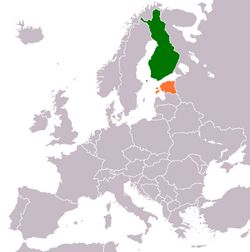Estonia–Finland relations
 | |
Finland |
Estonia |
|---|---|
Estonia–Finland relations are foreign relations between
. Both countries are full members of the Council of the Baltic Sea States, Council of Europe, European Union, NATO and the Eurozone. Finland has given full support to Estonia's membership of the European Union. Estonia also has strongly supported Finland's NATO membership. The majority languages in both countries are Finnic languages, as Finland's main language,


History
This section needs expansion. You can help by adding to it. (November 2023) |

Unification proposals
In Finland, the idea of a unified Greater Finland gained popularity and influence rapidly in 1917, but lost support after World War II and the Continuation War.
In 1917, 1918 and 1940, the Estonian president Konstantin Päts wished for a union of Finnic countries in his political testament, writing an outline of a unification plan. He used the term "soomesugu" in Estonian to point to the people and countries of Finland and Estonia when talking about common border law.[4][5]
Anthem
The Finnish anthem Maamme and the similarly themed Estonian anthem Mu isamaa, mu õnn ja rõõm (My Fatherland, My Happiness and Joy, 1869) share the same melody.
This song is also considered to be the ethnic anthem of
Regional cooperation
Finnish and Swedish investors are the largest foreign investors in Estonia.[2] Both Finland and Estonia are members of the European Union, Schengen Agreement and the Eurozone. Finland is Estonia's fourth greatest import partner, accounting for 8.48% of its imports between 2017 and 2021, as well as the greatest market for Estonia's exports, accounting for 12.2% of Estonia's exports.[6]
Finland's government recognised Estonia's independence in 1920. Finland contributed and continues to contribute military aid to Estonia, such as officers' training, and the provision of equipment.
The
Balticconnector is a bi-directional natural gas pipeline between Finland and Estonia.
Resident diplomatic missions
-
Embassy of Estonia in Helsinki
-
Embassy of Finland in Tallinn
See also
- Foreign relations of Estonia
- Foreign relations of Finland
- Finnish–Estonian defence cooperation
- Finnish Infantry Regiment 200
- Estonians in Finland
- Estonian–Finnish federation
References
- ^ "Third of Estonia's Alcohol Sales Attributed to Finnish Tourists". News.err.ee. 22 April 2014.
- ^ a b "Poliittiset suhteet - Suomen suurlähetystö, Tallinna". 10 June 2007. Archived from the original on 10 June 2007. Retrieved 11 January 2018.
- ^ "Ex-President Koivisto secretly funnelled money to support Estonian independence". YLE. 15 May 2017. Retrieved 31 August 2022.
Rausmaa's studies show that Finland contributed over 100 million Finnish marks towards Estonian independence by the year 1991. In addition to this material support, Finland provided expert consultation and training to its southern neighbour, which basically had to build a market economy and the system of democratic rule from scratch.
- ^ "Archived copy" (PDF). Archived from the original (PDF) on 2016-12-22. Retrieved 2017-01-05.
{{cite web}}: CS1 maint: archived copy as title (link) - ^ "Kuidas Konstantin Päts Eesti-Soome liitriiki soovis". Ohtuleht.ee. Retrieved 11 January 2018.
- ^ "Estonia Trade | WITS Data". wits.worldbank.org. Retrieved 2024-01-05.




